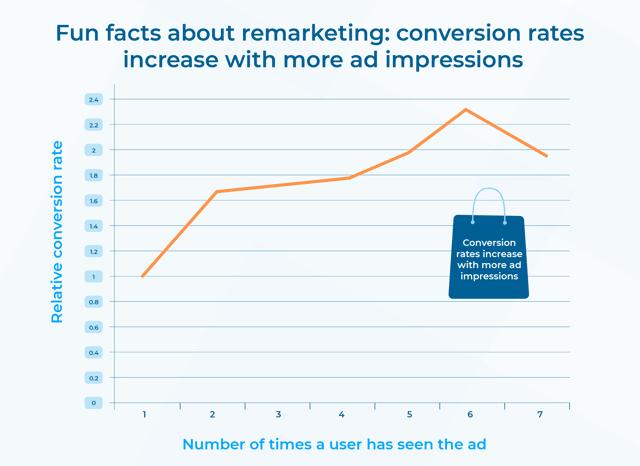.jpg)

Get monthly notifications
3 most important audience lists in Google Ads
Creating effective audience lists in Google Ads is an easy way to keep track of your re-marketing lists. In this post, we present you with our top three choices for audience lists that can prove valuable when working with your re-marketing campaigns.
Audience lists are a part of the Audience manager in Google Ads where you handle your re-marketing lists. Here you have an overview of your ads on YouTube, Google Search, Gmail, and the Google Display Network.
Through your re-marketing campaigns, you can choose which audiences see your ads. Once you’ve established an audience source you can choose to target all audiences and adjust bids for different audience types – or target only specific audiences and remove others.
For example, a restaurant could make a ‘lunch visitors’ list and add users that visit their site during lunch hours to a new re-marketing list. The list can be used in a ‘lunch specials’ campaign to target those users and increase traffic to their site for lunch orders. You could basically create a list for whatever you like but there are three main lists necessary to make an impact on your Google Ads sales.
Learn more about re-marketing: How to use re-marketing in Google Ads.
1) Cart abandoners
A 2018 study by Baymard shows that 69% of all e-commerce shoppers abandon their shopping cart. This is a highly interesting group to keep track of and something you definitely should create an audience list for. When they start searching for your products again - you need to have a re-marketing tag on them to make sure that they have seen an ad and remember to make another visit to your site.
2) Past buyers
For most e-commerce businesses this is the most important buyer to consider. These are the ones that have bought something from you before and are likely to return. For retail stores selling affordable sports products, past buyers are extremely important. A customer involved in weight training will most likely be interested in products like protein powder and sports nutrition and will buy these continuously. But if you are running a business with very exclusive, expensive products then you won’t have the same success in past buyers. If you are selling luxurious cars, it isn’t likely that a recent customer will come back to buy a new one in the short future, right?That's a one-time purchase, so you have to define your goals.
3) Top ten products
Before you can make an audience list for the top products in your assortment, you obviously need to know what they are. Creating an audience list for your ten best-performing products can help you stay on top of your Google Ads game. Continue by analyzing how sales have been going during the year and take into account how much you’ve spent on Google Ads for each category, brand, and product.

Other great audience lists in Google Ads
The three pointers mentioned audience lists as the ones we feel are most valuable, but there are obviously numerous ways to go when creating audience lists. Another great option is creating a top category. Say you have invested a lot in a new kind of sneaker and this is a product category you really want to grow in, then buying more traffic into this category will increase purchases. Another way to go is by creating VIP lists by figuring out which the most valuable customers are and find out what they like.
At Keywordio we work with metrics every day, and we help you to sort out who your most valuable customers are and how you should target them. We look at metrics as if they’ve spent more than two minutes on your site and/or visited more than five pages. When we’ve sorted out who they are we can bid up aggressively whenever they’re searching for your products again. Get in touch with us here.
Figure what your most valuable products are to target them for your most valuable customers, learn more: Optimize sales in Google Ads with your most valuable product.
Featured Articles
The Full Funnel Approach and Pinterest
Today, we're going to delve into the significance of working with a full-funnel strategy and understanding why a comprehensive media mix is crucial. We'll also explore an example of how this approach and including Pinterest in the media mix led to a significant decrease in the cost of sales for Houdini.
Master Text Overlays: Boost Ad Engagement
In recent years, capturing the attention of your target audience has become more challenging than ever. Businesses and marketers are constantly on the lookout for innovative ways to stand out in the crowded advertising landscape.
One effective technique to draw attention to your ad's message is through the use of text overlays on image and video ads. In this blog, we will explore the best practices for incorporating text overlays, ensuring your message is impactful without compromising the visual appeal of your ads.
Similar Articles
Protect Your Facebook Business Account from Phishing: Expert Tips by Keywordio
Hello everyone, Johan here from Keywordio. Today, I want to share crucial insights into phishing—what it is and how you can safeguard your Facebook business account from this prevalent threat.
Exploring the Future of TikTok: Insights from the 2024 Trend Report
Introduction
I'm excited to delve into TikTok's comprehensive "What's Next 2024 Trend Report." This report is a treasure trove for anyone in digital marketing, offering deep insights into the future of content, storytelling, and consumer engagement on TikTok.
E-Commerce Excellence: Meta's Advantage+ Shopping Campaigns Redefined
Welcome to the dynamic world of e-commerce, where Meta's Advantage+ shopping is reshaping how businesses connect with customers. In this blog post, we'll explore the key features of this innovative tool.
Introducing TikTok Shop
Today, I bring to your attention a revolutionary update from TikTok, a platform where over 150 million Americans seek daily doses of inspiration and entertainment. With a plethora of trends, fashion hacks, beauty nuggets, and a smattering of recipes, TikTok has emerged as a modern-day oracle for curious minds. The excitement in the air thickens as we unveil TikTok Shop to the US, an avant-garde conduit for folks to spot and snag their adored items seamlessly.
The Full Funnel Approach and Pinterest
Today, we're going to delve into the significance of working with a full-funnel strategy and understanding why a comprehensive media mix is crucial. We'll also explore an example of how this approach and including Pinterest in the media mix led to a significant decrease in the cost of sales for Houdini.
Master Text Overlays: Boost Ad Engagement
In recent years, capturing the attention of your target audience has become more challenging than ever. Businesses and marketers are constantly on the lookout for innovative ways to stand out in the crowded advertising landscape.
One effective technique to draw attention to your ad's message is through the use of text overlays on image and video ads. In this blog, we will explore the best practices for incorporating text overlays, ensuring your message is impactful without compromising the visual appeal of your ads.
The Next Big Thing: 5 Digital Marketing Trends to Watch for in 2023
Digital marketing is a constantly evolving field, shaped by emerging technologies, changing consumer behaviors, and the dynamic nature of the online landscape. Staying on top of the latest trends is crucial for businesses and marketers to effectively engage with their target audience and drive growth. In this introduction, we will explore some of the key digital marketing trends that have emerged in recent times.
The Power of Branding on Meta
Are you ready to unlock unparalleled opportunities and take your online business to new heights? In a rapidly evolving digital landscape, Meta continues to revolutionize the way marketers and entrepreneurs create an impact on buyers.
Today, we will talk about the immense potential of branding on Meta's platforms, Facebook and Instagram based on our Meta Branding (Online Course). Brace yourself for insights that will empower you to establish a strong brand identity, harness consumer trends, and optimize your advertising strategies like never before! Ready to spearhead your business to success? by understanding the potential of branding on Meta and how you can tap into it. Excited? So are we - let's get into it!
A Sneak Peek into Pinterest's 2023 Product Updates!
Pinterest is improving its Ads Manager to provide a seamless experience for advertisers. New features will be released throughout 2023 to optimize advertising strategies. Pinterest aims to offer powerful tools and insights for better campaign results. Get a sneak peek into the exciting updates coming to Ads Manager this year.